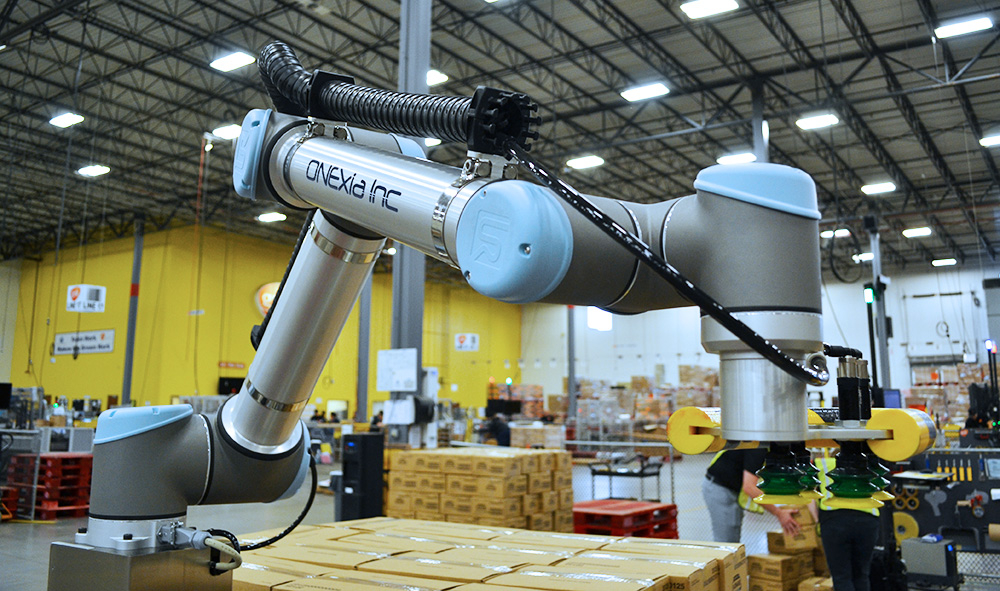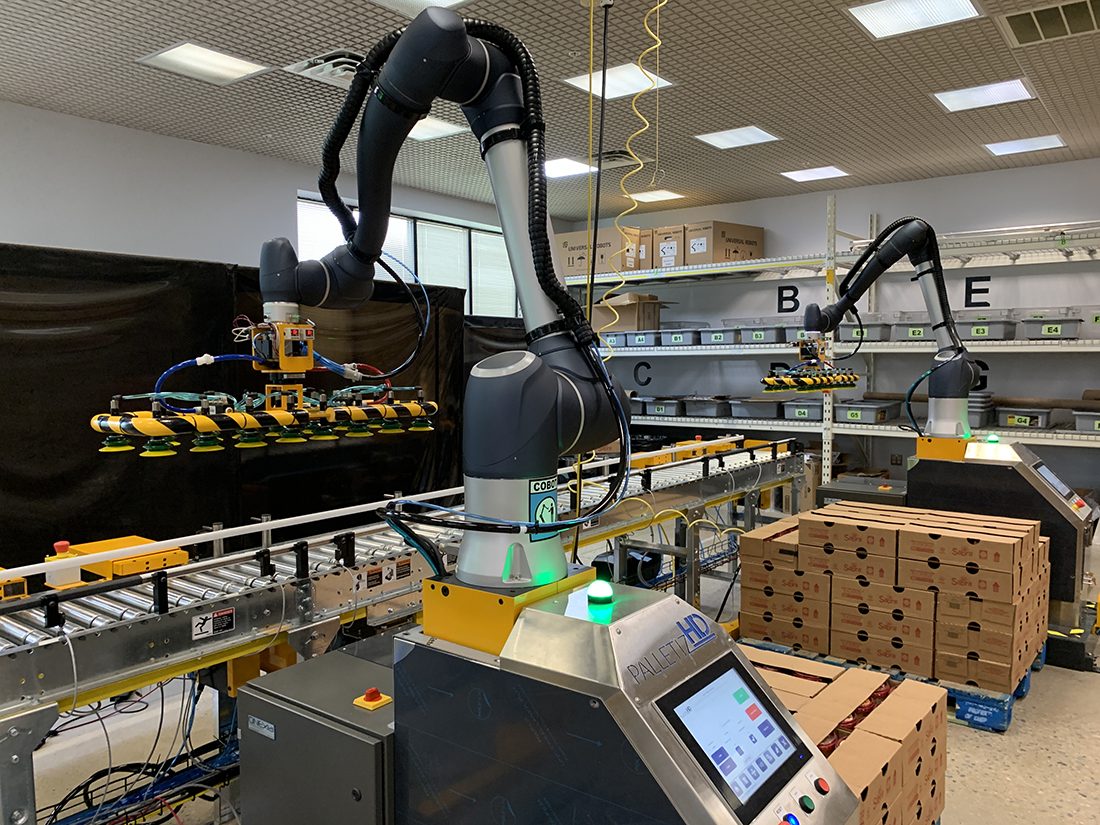In the dynamic world of manufacturing, efficiency, and optimization are the keystones of success, particularly for small to mid-sized companies striving to keep up with the demands of the market. One aspect of factory automation that plays a pivotal role in achieving such efficiency is palletizing.
But, what is palletizing? Simply put, robot palletizing is the process of stacking products or packages onto a pallet for easy transport and storage. This seemingly straightforward task is integral to automated packaging systems and can significantly impact your operation’s throughput and reliability.
Understanding Palletizing
At its core, robot palletizing involves arranging products on a pallet in a specific order and pattern to maximize space and ensure stability during transportation. This process is not new; however, the methods and technologies involved have evolved tremendously, particularly with the introduction of robotic palletizers and palletizing automation systems.
The Evolution from Manual to Robotic Palletizing
Traditionally, palletizing was a manual task performed by workers, which, while effective, posed limitations in terms of speed, consistency, and worker safety. The advent of factory automation with palletizers brought about a significant shift with the development of mechanical and later, robotic palletizing systems. These advancements have not only enhanced efficiency but also reduced the physical strain on workers and improved overall safety in the workplace.
Robotic Palletizing Systems

Robotic palletizing systems have become a game-changer in the world of automated packaging systems. These systems employ sophisticated robots, often referred to as robot palletizers, to automate the stacking of goods onto pallets. The capabilities of these robots vary, from simple, single-SKU palletizing to more complex systems capable of handling multiple SKUs simultaneously.
Key Components
-
- Robotic Arm: At the heart of every robotic system lies the robotic arm, a marvel of engineering designed for precision and strength. It’s this arm that brings the agility needed to pick, place, and stack products with unparalleled accuracy.
-
- End-of-Arm Tooling (EOAT): The versatility of EOAT, ranging from advanced grippers to adaptive suction cups, allows for the handling of diverse products, ensuring that each item, regardless of its shape or size, is securely grasped and accurately placed.
-
- Conveyor Systems: Serving as the arteries of the palletizing process, conveyor systems efficiently transport products to the palletizing zone, ensuring a continuous flow of items to be stacked, which is crucial for maintaining operational momentum. Palletizers can also tend two conveyor systems simultaneously!
-
- Control Systems: The brain behind the operation, control systems employ sophisticated, yet simple software to orchestrate the robotic arm’s movements and the execution of complex palletizing patterns, ensuring every stack is optimally configured for stability and space utilization.
The Top Four Benefits of Robotic Palletizers:
-
- Increased Efficiency: Robotic palletizers operate with relentless consistency, dramatically slashing the time needed to stack goods on pallets. This unyielding pace ensures that production lines keep moving swiftly, boosting overall throughput.
- Improved Safety: By taking over the physically demanding task of palletizing, collaborative robots mitigate the risk of workplace injuries, creating a safer environment for employees and reducing the potential for costly downtime.
- Flexibility: The adaptability of robotic systems is unmatched, with the ability to swiftly reprogram for different products or pallet configurations, allowing businesses to respond quickly to changing market demands or product lines.
- Scalability: Robotic palletizer solutions seamlessly blend into existing production frameworks, offering the flexibility to scale up operations or adapt to new product lines without extensive overhauls, making them an ideal choice for growing businesses.
Key Terms in Palletizing Automation:
-
- Automated Packaging Systems: This term encapsulates a wide array of machines designed to streamline the packaging process, from the initial stages of filling and sealing right through to the critical step of palletizing, ensuring efficiency and consistency throughout.
-
- Automation Integrators: These are the experts who craft bespoke automation solutions, skillfully weaving together various technologies to create a system that meets the unique demands of your production line, ensuring a smooth and efficient workflow.
-
- Palletizer Manufacturers: These entities specialize in the creation of this machinery, offering a spectrum from basic models to cutting-edge robotic systems, empowering businesses with the tools needed for efficient stacking and handling.
-
- Case Packaging Equipment: Essential machinery that automates the boxing of products, case packers work in harmony with palletizing systems to deliver a streamlined end-to-end solution for packaging needs, enhancing efficiency and reliability.
-
- Robotic Case Packer and Palletizer: This integrated system epitomizes efficiency by automating the entire process from case packing to palletizing, significantly streamlining operations and optimizing the use of space and time in the packaging process.
Implementation Considerations:
-
- Product Characteristics: The physical attributes of your products, such as their size, shape, and weight, play a critical role in determining the most suitable palletizing system and EOAT, ensuring that each item is handled with care and precision.
-
- Production Volume: The scale and scope of your operations will directly influence the complexity and capacity of your palletizing solution, ensuring that it can meet your production demands efficiently and effectively.
-
- Space Constraints: The layout and available space within your facility are crucial factors that will shape the design and footprint of your palletizing system, ensuring that it integrates smoothly into your existing operations without disrupting the flow.
-
- Integration with Existing Systems: Seamless integration of the palletizing system with your current production lines and ERP software is essential for maintaining a cohesive and efficient workflow, ensuring that all components of your operation communicate effectively.
-
- Future Scalability: Planning for future expansion and potential shifts in product offerings is vital, ensuring that your palletizing solution can adapt and grow alongside your business, safeguarding your investment for years to come.
Choosing the Right Palletizing Solution
-
- Assess Your Needs: Start by clearly articulating the specific requirements and goals of your operation, ensuring that any palletizing solution you consider can meet these essential criteria.
-
- Research Options: Dive deep into the various palletizing technologies available, understanding their capabilities and limitations, to identify the options that align best with your operational needs.
-
- Consult Experts: Leverage the knowledge and experience of manufacturers and automation integrators, who can provide valuable insights and recommendations tailored to your unique production environment.
-
- Evaluate ROI: Carefully weigh the initial investment against the potential benefits, such as increased efficiency, reduced labor costs, and improved safety, to determine the most cost-effective palletizing solution.
-
- Plan for Implementation: Develop a comprehensive strategy for integrating the chosen palletizing system into your operations, considering aspects such as training, workflow adjustments, and system customization, to ensure a smooth transition and optimal performance
Significantly Enhanced Operations
In answering the question, we’ve uncovered the pivotal role it plays in the modern manufacturing landscape, especially within the realm of automated packaging systems and factory automation. The shift towards robotic palletizing systems has brought about significant efficiencies, safety improvements, and scalability options for small to mid-sized manufacturing companies.
By understanding the fundamentals of palletizing, exploring the available technologies, and carefully planning the implementation, facility supervisors and business leaders can significantly enhance their operations, positioning their companies for success in an increasingly competitive market.
Whether it’s through integrating a simple robotic case palletizer or a more complex robotic palletizer system, the benefits of adopting palletizing automation are clear and compelling. If you have any questions about integrating a palletizer into your end-line procedures, contact our team of engineers today.

